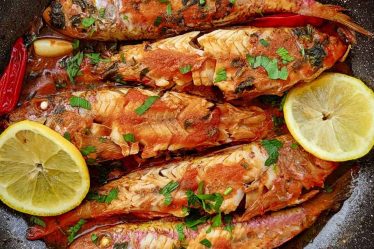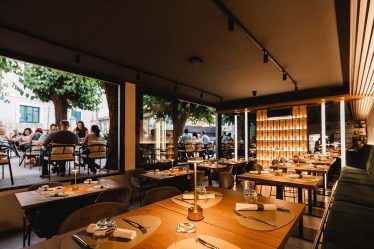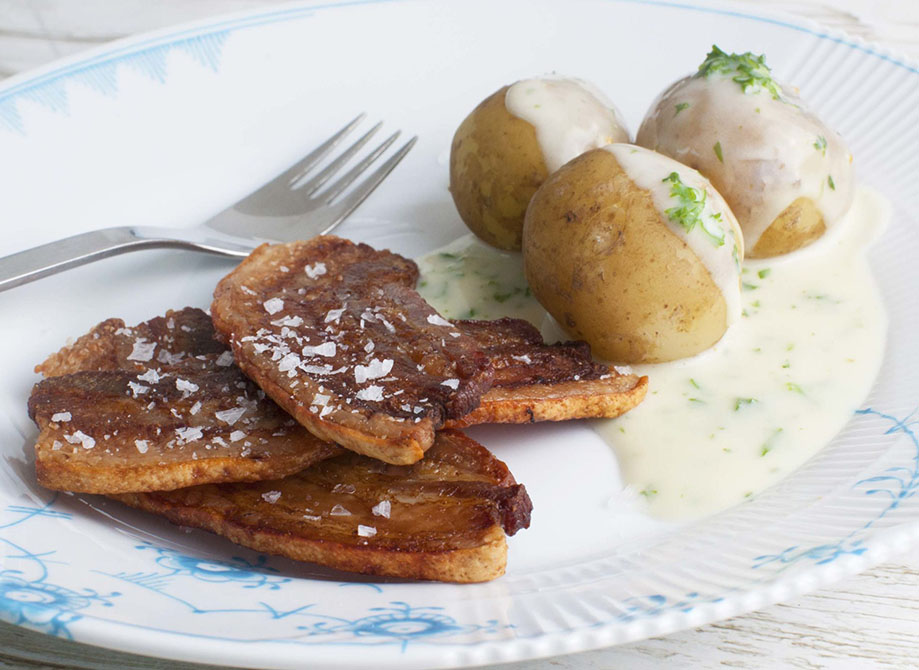
When I first landed in Aalborg, Denmark’s charming northern gem, I was expecting a lot—Viking history, colorful houses, and perhaps a crisp coastal breeze drifting in from the Limfjord. Tucked away from the hustle of Copenhagen and often overlooked by guidebooks, Aalborg felt like the kind of place where time slows down just enough for you to catch your breath. But what took me completely by surprise—and quickly stole my heart—was the culinary scene.
I’ll admit, I came for the history, but I stayed for the food.
Aalborg may not yet be on the radar of international foodies, but when it comes to traditional Danish cuisine, this city punches well above its weight. The food here isn’t just good—it’s honest, comforting, and deeply connected to Danish culture and everyday life.
If you’re like me—someone who travels with their stomach leading the way—then you’re in for a treat. From hearty open-faced sandwiches to savory meat dishes, fresh seafood, and delicate pastries, Aalborg offers a delicious introduction to Denmark’s culinary heart. Here are eight must-try Danish dishes you absolutely shouldn’t miss while visiting, each paired with my personal experience and local tips on where to find them.
1. Smørrebrød – The Classic Danish Open-Faced Sandwich
Before arriving in Aalborg, I’d heard of smørrebrød, but I had no idea just how artistic and flavorful these little sandwiches could be. Made with a base of dense, dark rye bread (rugbrød), each slice is meticulously topped with ingredients like pickled herring, shrimp and eggs, roast beef, or liver pâté with crispy onions.
My first bite came from Mortens Kro, a slightly upscale but welcoming spot right in the city center. I ordered the “classic trio” plate, which gave me a sampling of herring, egg & shrimp, and roast beef. The textures, the contrast between the creamy toppings and the crunchy bread, the pop of pickles—it was a total flavor adventure.
📍 Where to try it: Mortens Kro or Café Peace (for a more casual option)
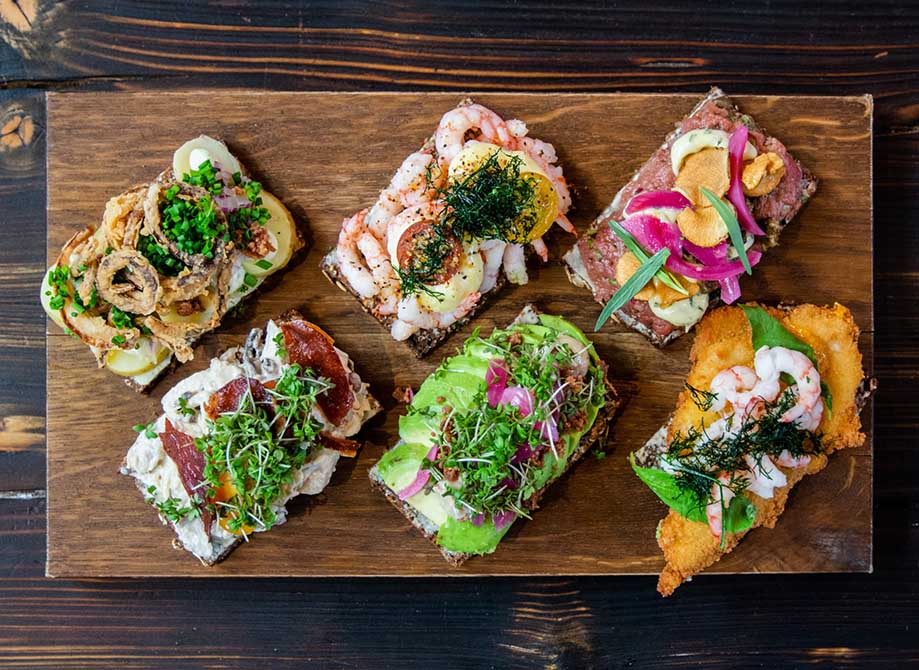
2. Stegt Flæsk – Crispy Pork Belly with Parsley Sauce and Potatoes
I call this one “the dish that stole my heart.” Stegt flæsk is Denmark’s national dish for a reason. It’s rich, salty, comforting, and unapologetically indulgent. Imagine thick slices of pork belly, pan-fried until perfectly crispy, served with boiled potatoes and a creamy parsley sauce.
I tried this at Restaurant Flammen, which offers a traditional Danish buffet (great if you want to try many things). The crunch of the pork belly skin combined with the soft potatoes and that fresh green sauce—it reminded me of a Sunday family meal back home, even though I was thousands of kilometers away.
💡 Pro Tip: Don’t be afraid to ask for extra sauce. It’s the best part.
3. Frikadeller – Danish Meatballs
Every culture has its version of meatballs, but frikadeller are uniquely Danish. These aren’t your typical round, Italian-style balls. Instead, they’re pan-fried, oblong patties made from minced pork or a pork/beef mix, seasoned with onion, pepper, and sometimes a touch of nutmeg.
I had these on my second night at a cozy little place called Hos Henius, tucked behind the old town. Served with creamy potatoes and braised red cabbage, the frikadeller had a crusty edge and juicy interior. It felt hearty and homey, like something your Danish grandmother might make if you were lucky enough to have one.
4. Rødgrød med Fløde – Red Berry Pudding with Cream
I admit, the name is a bit of a tongue twister (try saying rødgrød med fløde three times fast!), but this simple dessert was one of the highlights of my trip. Made from red berries—typically strawberries, raspberries, red currants—cooked down into a thick, sweet-tart pudding, and topped with cold cream, this dish is light, fresh, and nostalgic.
I stumbled upon this treat at Café Ulla Terkelsen London, a trendy spot with a retro vibe. Served in a small glass jar, it was sweet without being overpowering, and the berries tasted like a Danish summer.
🍓 Try it during berry season (late spring through summer) for the freshest experience.
5. Rugbrød – Danish Rye Bread
It’s impossible to talk about Danish food without mentioning rugbrød. This dense, dark, seeded rye bread is the foundation of many Danish meals, especially smørrebrød. But it’s also delicious on its own, with a smear of butter or cheese.
As someone who usually leans toward fluffy white bread, I was surprised by how addictive rugbrød became during my stay. I even started every morning with a slice and some local cheese or jam. I found the best loaf at Fru Ronne’s Bageri, a local bakery with a long queue (a good sign!). The hearty texture, subtle sourness, and nutty finish made it both healthy and satisfying.
6. Karbonader – Breaded Pork Patties
One rainy afternoon, I wandered into Café Penny Lane, soaked from exploring the waterfront, and spotted karbonader on the chalkboard menu. I’d never heard of them before, but I’m so glad I gave them a try.
Karbonader are breaded and fried pork patties, sort of like a Danish take on schnitzel. Served with peas, carrots, and boiled potatoes, this dish felt like something from another era—in the best way. It was warm, filling, and the crispy crust on the patty added such a satisfying crunch.
🥘 This dish is especially common in winter months as a comfort food classic.
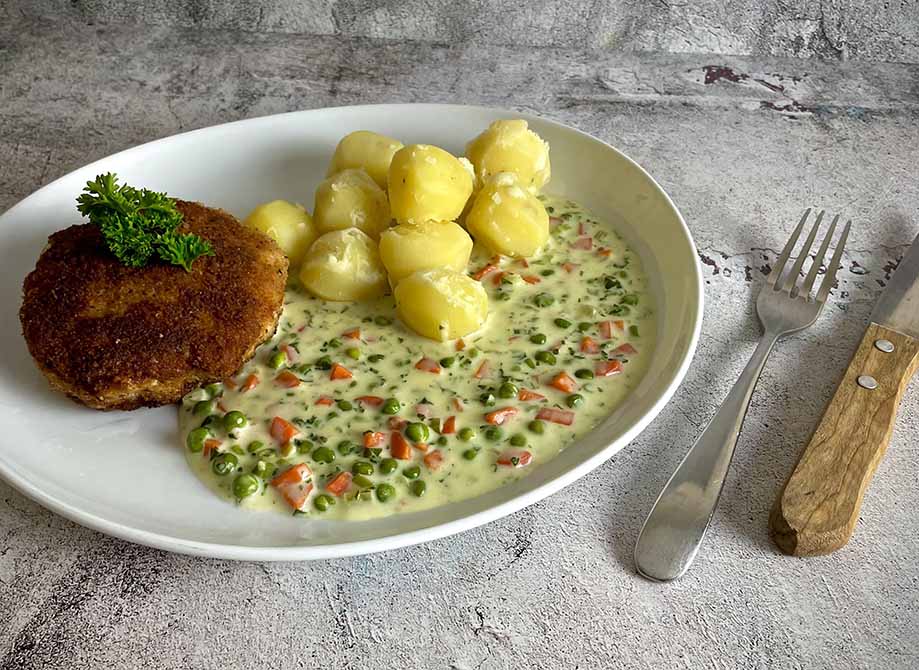
7. Tarteletter – Chicken and Asparagus in Pastry Shells
Tarteletter are flaky pastry cups filled with a creamy chicken and white asparagus ragout, and they’re typically served during Danish holidays or as part of traditional family dinners. I tried them during a Sunday lunch at Restaurant Menendez, where they were presented elegantly, but still felt humble and comforting.
The filling was creamy and mildly spiced, and the puff pastry shell was light but sturdy. Every bite was indulgent yet delicate—exactly what I didn’t know I needed on a chilly afternoon.
🥄 Bonus: Goes perfectly with a cold Carlsberg or a light white wine.
8. Æbleskiver – Danish Pancake Balls
No list of Danish food is complete without dessert, and æbleskiver are pure joy. These round, fluffy pancake balls, often filled with apple, jam, or just plain, are dusted with powdered sugar and served with fruit preserves.
I first encountered æbleskiver during Aalborg’s Christmas market (if you’re lucky enough to visit during the holidays, don’t miss it!). The smell alone drew me in. I ordered a portion, took my first bite, and instantly smiled—it was like a warm hug in food form.
Even outside the holiday season, some cafés like Behag Din Smag serve æbleskiver as a sweet treat. Paired with a hot cup of gløgg (Danish mulled wine), it’s the ultimate comfort combo.
Traveling to Aalborg was one of the most delightfully unexpected culinary adventures I’ve had in Europe. Nestled in northern Denmark, this city may be best known for its Viking roots, waterfront charm, and thriving art scene, but what truly stayed with me was the depth and soul of its food culture.
From the very first bite of a perfectly balanced smørrebrød to the last spoonful of rødgrød med fløde, every dish told a story. What I loved most wasn’t just the flavors—though they were rich, nuanced, and comforting—but the spirit behind the food. Aalborg’s cuisine feels authentic, rooted in tradition, and made with genuine care. There’s a certain unpretentious honesty in Danish cooking—nothing feels overcomplicated or showy. It’s about balance, seasonality, and making the most of simple, quality ingredients.
Everywhere I went, from stylish modern restaurants to family-run cafés and bakeries, I encountered this same quiet pride in local culinary heritage. The hospitality in Aalborg is equally warm and understated. People don’t hover over your table or rush you to order—they give you space. Space to eat, space to think, and most importantly, space to enjoy. That’s something I didn’t know I needed until I was sitting in a cozy café by the waterfront, sipping hot coffee and biting into a piece of freshly baked rugbrød, watching the light dance across the Limfjord.
And then there’s hygge—a word that defies direct translation but defines so much of what I felt during meals in Aalborg. It’s the warmth of candlelight on a gray afternoon, the quiet joy of eating something homemade, the comfort of a shared dish between friends. The Danes don’t just eat to fuel up; they savor food as part of a lifestyle, a moment to connect with others or simply unwind. Dining in Aalborg, even alone, felt like a celebration of slowness—something truly rare in today’s fast-paced travel culture.
Whether you’re a devoted foodie seeking out the next under-the-radar culinary capital, or just a curious traveler wanting to experience something local and authentic, Aalborg delivers. These eight dishes I’ve shared are more than just menu items—they’re gateways into Danish identity, history, and soul.
So my advice? Take your time. Eat with curiosity. Order that second helping of stegt flæsk. Linger over dessert. Ask the waiter about their favorite dish. You’ll leave Aalborg with more than just photos—you’ll take with you the memory of flavors, textures, and moments that warm you from the inside out.
And trust me, your taste buds will thank you—long after you’ve left the cobblestone streets and Baltic breeze behind.
